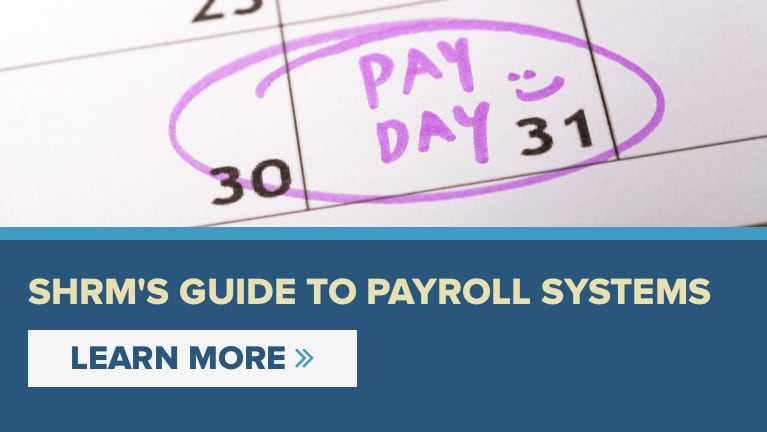The HR technology industry has experienced a renaissance over the past few years as vendors have introduced a bevy of modern, user-friendly features designed to meet client's new needs. Yet arguably, one of the most important platforms has often been left behind in that movement: payroll systems.
In many organizations, payroll systems are outdated and lack the modern capabilities needed to meet changing business and compliance needs.
A new survey from the American Payroll Association and Kronos found that almost 30 percent of respondents are using systems that are more than 10 years old, and almost half of polled organizations don't track and report on key performance indicators in their payroll functions. The survey includes responses from 1,000 payroll professionals in small, midsize and enterprise-size companies across industries.
[SHRM members-only online discussion platform: SHRM Connect]
Costs of the Status Quo
Organizations have been reluctant to upgrade aging payroll systems for a handful of reasons, experts said. Atop that list is a desire to avoid fixing what isn't broken. Most legacy payroll systems are on-premise models that have been highly customized with multiple integrations to other HR systems. Payroll professionals can be reluctant to introduce change for fear of creating problems in a process in which data accuracy and system reliability are paramount.
Major payroll providers often offer plans for clients with older, on-premise systems to transition to newer, cloud-based versions, said Mollie Lombardi, co-founder and CEO of advisory and analyst firm Aptitude Research Partners, which recently completed a major study of the global payroll market. But many payroll leaders are hesitant to make the change because of a risk-averse nature. "Payroll touches everyone in the organization, and there's a belief [that] a system change needs to be as painless as possible," Lombardi said.
Experts said many modern payroll systems can help HR provide enhanced levels of service and strategic support to organizations. Lombardi's study found that many of these platforms have expanded self-service options that can help boost employee engagement, new on-demand reporting tools and an ability to create seamless integration with time and labor-management systems. Aptitude's study included 500 respondents across industries and company sizes.
Failure to modernize payroll systems has real costs, said Sam Grinter, a senior research analyst with research and advisory firm Gartner, based in Stamford, Conn., who recently published a study on multicountry payroll solutions. Outdated, heavily customized applications require scarce and often costly resources to adapt to changing legislative compliance requirements and shifting end-user demands, Grinter said.
"While in theory older systems shouldn't break down due to age because vendors make promises to continually invest in maintaining or upgrading them, that isn't always the case," Grinter said. "Levels of investment by vendors in these systems is variable."
Another drawback of aging payroll systems is an ability to comply with regulations like the recently enacted General Data Protection Regulation (GDPR). Similar data privacy laws may be introduced around the world in coming years, said Stacey Harris, vice president of research and analytics with HR technology advisory firm Sierra-Cedar. GDPR requires organizations operating in the European Union (EU) or doing business there to protect the personal data and privacy of EU residents.
"Payroll systems need an ability to access and remove employees' personal information, which isn't easy to do without disturbing historical data," Harris said. "That's a challenge and risk with older payroll systems that have been highly customized. They may contain data and tables that can't be easily removed or encrypted in a way that the data can be maintained for longer-term needs or compliance requirements in many countries."
Capabilities of New Systems
Payroll providers serving small as well as large companies have developed next-generation systems with a variety of new capabilities. Lombardi said by harnessing the power of the cloud and separating processes like payroll reporting from payroll calculations, some vendors have transformed batch processes that once took hours to complete into a real-time view of payroll status at any point in a pay cycle. That capability allows companies to adopt practices like same-day pay for hourly workers, Lombardi said, an approach proving to be an effective recruiting and retention tool in some industries.
Aptitude's payroll study also found other innovations, including increased use of mobile self-service apps, chatbots and proactive communication tools designed to relieve HR's administrative burden and improve customer service. Self-service and a greater focus on the employee experience are hallmarks of modern payroll systems, Harris said. "We've seen the adoption of self-service technology increase dramatically even for smaller and midmarket companies, since many employee questions come in the area of payroll," she said. "Organizations are really rethinking the idea of what the help-desk model in HR should look like."
The number of payroll providers targeting the small and midsize markets has grown rapidly, Lombardi found in Aptitude's report, in part because those businesses find themselves with increased regulatory requirements that once affected only larger enterprises. The economics of software-based products also are allowing smaller businesses to capitalize on that technology to meet compliance needs, Lombardi said.
Some providers also have added features that facilitate improved sharing and analysis of payroll data across a company. On-demand analytics and reporting allow functions like operations and finance to leverage payroll data when making business decisions and to improve insight into labor costs. "The idea of generating real-time data from payroll systems was previously unheard of," Harris said.
How effectively payroll is integrated with other systems also can play a role in the ability to recruit and retain talent. Offerings like student loan repayments, retirement investments and even pet-sitting services require myriad payroll deductions and thus system flexibility and interoperability, Lombardi said. Integration with third-party providers collecting payroll deductions ranked in the top three provider selection criteria in the Aptitude survey, behind only cost and automatic tax updates.
Dave Zielinski is a freelance business writer and editor in Minneapolis.
An organization run by AI is not a futuristic concept. Such technology is already a part of many workplaces and will continue to shape the labor market and HR. Here's how employers and employees can successfully manage generative AI and other AI-powered systems.





